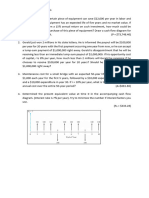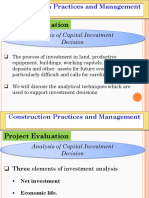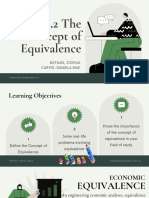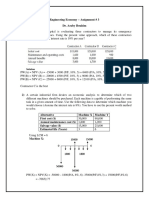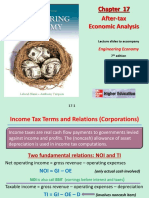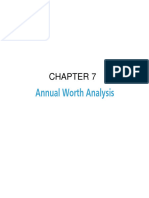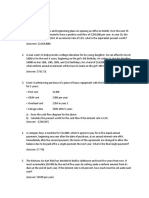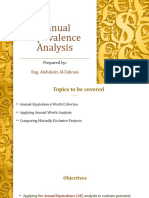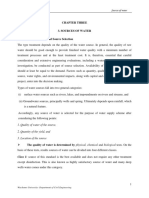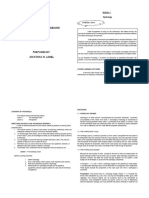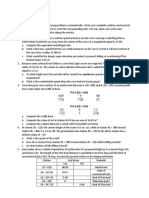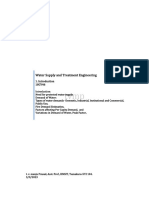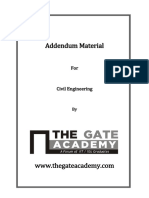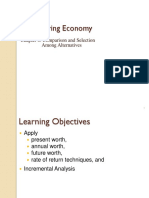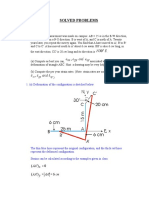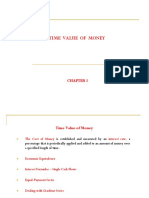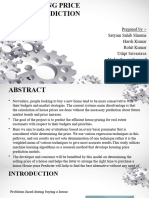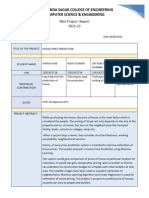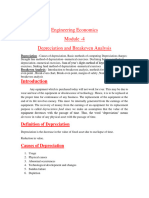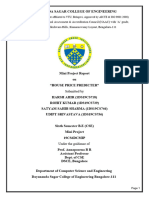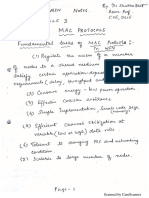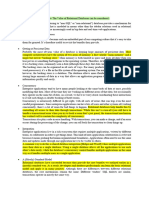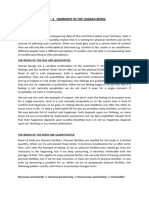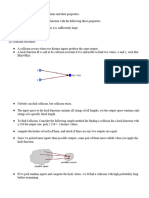0 ratings0% found this document useful (0 votes) 218 views26 pagesMod 2 Problems
Copyright
© © All Rights Reserved
We take content rights seriously. If you suspect this is your content,
claim it here.
Available Formats
Download as PDF or read online on Scribd
EE_Module_2
Engineering Economics
Module -2
Present Worth Comparisons
Present worth(PW)
In this method of comparison, the cash flows of each
alternative will be reduced to time zero by assuming an
interest rate i. In most of the practical decision environments,
executives will be forced to select the best alternative from a
set of competing alternatives.
There are 5 basic methods to have results of
selected alternative or to be analysed
Equivalent worth :
i) Present worth (PW)
ii) Annual worth (AW)
iii) Future worth (FW)
Rate of returns
i) Internal rate of return(IRR)
ii) External rate of return(ERR)
Prepared by Prof.Navyashree TM, CSE, DSCE�EE_Module_2
Conditions for PW comparisions
1. Cash flows are known
2. Cash flows are in constant value Rs.
3. The interest rate is known
4. Comparisions are made with before-
tax cash flows
5. | Comparisions do not include intangible
considerations
6. Comparisions do not include
consideration of the availability of funds to
implement alternatives
REVENUE-DOMINATED CASH FLOW DIAGRAM
A generalized revenue-dominated cash
flow diagram to demonstrate the present worth
method of comparison is presented in Figure
fit
pee
Fig. 4.1 Revenue dominated cashflow diagram
In Fig. 4.1,
Prepared by Prof.Navyashree TM, CSE, DSCE�EE_Module_2
P represents an initial investment
Rj the net revenue at the end of the jth year.
The interest rate is i, compounded annually.
S is the salvage value at the end of the nth
year.
Expenditure is assigned a negative sign and
revenues are assigned a positive sign.
If we have some more alternatives which
are to be compared with this alternative, then
the corresponding present worth amounts are
to be computed and compared.
Finally, the alternative with the maximum
present worth amount should be selected as
the best alternative.
COST-DOMINATED CASH FLOW DIAGRAM
A generalized cost-dominated cash flow
diagram to demonstrate the present worth
method of comparison is presented in Fig. 4.2.
° 1 2 jo: : ®
Prepared by
&�EE_Module_2
In Fig. 4.2,
P represents an initial investment
Cj the net cost of operation and maintenance
at the end of the jth year
S the salvage value at the end of the nth year
Expenditure is assigned a positive sign and
the revenue a negative sign.
If we have some more alternatives which
are to be compared with this alternative, then
the corresponding present worth amounts are
to be computed and compared.
Finally, the alternative with the minimum
present worth amount should be selected as
the best alternative.
Basic PW comparisions
The present worth of a cash flow overtime is
its value today is represented as time ‘0’ ina
cash flow diagram.
Two general patterns are,
Prepared by Prof.Navyashree TM, CSE, DSCE�EE_Module_2
i) Present worth Equivalence
Example problem
1. The lease on a warehouse amounts to
Rs.5000 per month for 5yrs. If payments
are made on the first of each month,what is
the present worth of the agreement at a
nominal annual interest rate of 12%
compounded annually.
A=5000
N=5*12=60months i=12%=12/12=1%
PW=A(P/A,1%,60)
= 5000(P/A,1%,60)
=5000 * 44.955
PW=2,24,775
ii)Net Present Worth
It has an initial outlay at time 0 followed
by a series of receipts and disbursements.
Net present-worth = PW (benefits) — PW (costs)_
Prepared by Prof.Navyashree TM, CSE, DSCE�EE_Module_2
Example problem
1.A piece of new equipments was proposed by
engineers to increase the production of a certain
manual welding operation. The investment is
Rs.25000 and the equivalent will have salvage
value of Rs.5000 at the end of Syrs. Increased
productivity will gain Rs.8000 per year after extra
operating costs have been subtracted from the
additional production, with rate of interest
20%.Use present worth method.
Ans:
Total PW=PW of cash receipts — PW of cash outlays
= 8000(P/A,20%,5)+5000(P/F,20%,5) - 25000
=8000(2.991) + 5000(0.4019) — 25000 using table
Total PW=934.5
Problems based on the Concept _of _PW method of
comparison applied to the selection of best alternative.
Problems
1.Alpha industry is planning to expand its
production operation. It has identified three
different technologies for meeting the goal. The
initial outlay and annual revenues with respect to
each of the technologies are summarized in Table
Prepared by Prof.Navyashree TM, CSE, DSCE�EE_Module_2
below. Suggest the best technology which is to
be implemented based on the present worth
method of comparison assuming 20% interest
rate, compounded annually.
Initial Annual Life
outlay revenue (years)
(Rs.) (Rs.)
Technology | 12,00,000 | 4,00,000 | 10
1
Technology | 20,00,000 [6,00,000 | 10
2
Technology | 18,00,000 | 5,00,000 | 10
3
In all technologies, the initial outlay is assigned
negative sign and annual revenues are assigned
positive sign
Technology 1
P=12,00,000
A=4,00,000
i=20%
n=10 years
The cas flow diagram of this technology isos shown ia Fig. 4.3.
Aonge soy amen 5, 4cume
sone
Fig. 43. Cath low diagram for techusogy
PW (20%) = -12,00,000 + 4,00,000(P/A,20%, 10)
Prepared by Prof.Navyashree TM, CSE, DSCE�EE_Module_2
= -12,00,000 + 4,00,000 * 4.192
PW(20%) = Rs. 4,76,800
Technology 2
P=20,00,000 , A=6,00,000 i=20% , n=10
The cath flow diagram of this technology iz shown in Fig. 4.1
600.000 6,00.000 6,00,000
° r 2 - - 10
f= 20%
20.00.00
Fig. 44 Cash flow diagram for technology 2
PW(20%)= -20,00,000 + 6,00,000(P/A,20%, 10)
=-20,00,000 + 600,000 * 4.192
PW(20%)=5,15,200
Technology 3
A=5,00,000 , i=20%, n=10
J tic technology ie shown in Fig. 45.
00,000 5,00,000 s,00,000
o 1 2 * 10.
15,0010
Fig. 45 Cach Slow diagram for technology 3
PW(20%)= -18,00,000 + 5,00,000(P/A,20%, 10)
=+18,00,000 + 5,00,000 * 4.1925
PW(20%)=2,96,250
Prepared by Prof.Navyashree TM, CSE, DSCE�EE_Module_2
Technology 2 should be considered.
2. An engineer has two bids for an elevator to be
installed in a new building. The details of the
bids for the elevators are as follows:
Bid Engineers estimates
Initial Service | Annual
cost life operations and
(Rs.) (years) | maintainance
costs(Rs)
Alpha 4,50,000 | 15 27000
elevator
Beta 5,40,000 | 15 28500
elevator
Determine wl
Bid 1 : Alpha elevator
ich bid should be accepted, based on
the present worth method of comparison assuming
15% interest rate, compounded annually.
P=4,50,000 A=27,000 n=15 i=15%
PW(15%) = 4,50,000 + 27,000 (P/A,15%,15)
PW(15%)=6,07,879.80
Prepared by Prof.Navyashree TM, CSE, DSCE
=4,50,000 + 27000 * 5.8474�EE_Module_2
‘The cach flow diagram of bid 1 ie chowa ia Fig. 4.6
Fig. 46 Cosh How diagram for bid 1
Bid 2 : Beta elevator
P=5,40,000 A=28,500 n=15 i=15%
PW(15%)=5,40,000 + 28,500 (P/A,15%,15)
=5,40,000 + 28,500 * 5.8474
PW(15%)=7,06,650.90
The cash flow diagram of bid 2 is shown in Fig. 4.7
ts
I
abe
0 1 2 a 4
Fig. 4.7 Cash flow diagram for bid 2.
Alpha elevator should be implemented.
3. Investment proposals A and B have the net cash
flows as follows:
Proposals End of years
0 1 2 3 4
A(Rs.) =te000 3000 3000 7000
B(Rs.) 29.000 000 000 ~—~—=3000
Prepared by Prof.Navyashree TM, CSE, DSCE�EE_Module_2
Compare the present worth of A with that of B at i = 18%.
Which proposal should be selected?
Proposal A
Present worth of A af f— 18%, ‘The cash flow diagram of proposal A is
shown in Fig. 4.8.
3.000 e - “
ot 2 2 4
pany
so600
iA CA SR a
PW(18%)=-
10,000+3000(P/F, 18%, 1)+3000(P/F,18%,2)+7000(P/F,18%,3
)+6000(P/F,18%,4)
=-10,000 + 3000 (0.8475) + 3000(0.7182) + 7000(0.6086) +
6000(0.5158)
PW(18%)= Rs. 2052
Proposal B
Present worth of B at i= 18%. The cash flow diagram of the proposal
B is shown in Fig. 49.
6000 64 ©3000 3.000
10,000
Fig. 4.9 Cash flow diagram for proposal B
PW(18%)= -10,000 + 6000(P/F,18%,1) + 6000(P/F,18%,2) +
3000(P/F,18%,3) + 3000(P/F,18%,4)
Prepared by Prof.Navyashree TM, CSE, DSCE�EE_Module_2
= -10000 + 6000 (0.8475) + 6000 (0.7182) +3000(0.6086) +
3000(0.5158)
PW(18%) = Rs.2766.2
The PW of proposal B is higher than proposal A . so select
proposal B.
4.A granite company is planning to buy a fully
automated granite cutting machine. If it is purchased
under down payment, the cost of the machine is Rs.
16,00,000. If it is purchased under installment basis,
the company has to pay 25% of the cost at the time of
purchase and the remaining amount in 10 annual equal
installments of Rs. 2,00,000 each. Suggest the best
alternative for the company using the present worth
basis at i= 18%, compounded annually.
Two alternatives,
i) Down payment = Rs.16,00,000
ii) Down payment of Rs.4,00,000 and 10 annual
equal installments of 2,00,000 each.
PW(18%)=4,00,000 + 2,00,000 (P/A,18%, 10)
=4,00,000 + 2,00,000 * 4.494
PW(18%)=12,98,800
2eBe00 202000 202000 200%
400,000 18%
Fig, 410 Cash fow diagram fer the second stommtive
Prepared by Prof.Navyashree TM, CSE, DSCE�EE_Module_2
Second alternative should be selected.
wn
. A small business with an initial outlay of Rs. 12,000
yields Rs. 10,000 during the first year of its operation
and the yield increases by Rs. 1,000 from its second
year of operation up to its 10th year of operation. At
the end of the life of the business, the salvage value is
zero. Find the present worth of the business by
assuming an interest rate of 18%, compounded
annually.
A= Al +G(A/G,18%,10)
=10,000 + 1000 (3.194)
A=13,194
PW(18%) = -12,000 +A (P/A,18%,10)
= -12,000 + 13,194 (4.494)
PW(18%) = 47,293
6.A company borrowed 1,00,000 to finance a new
product the loan was for 20 years at a nominal interest
rate of 8% compounded semiannually. It was to be
repaid in 40 equal payments. After one half (1/2) the
payments were made, the company decided to pay the
remaining balance in one final payment at the end of
the 10" year how much was owed?
P=1,00,000 N=20years = 20 * 2 = 40 installments
Prepared by Prof.Navyashree TM, CSE, DSCE�EE_Module_2
i=8% Compounded semi-annually = 8/2=4%
i) F20=P (FIP, 4%, 20)
= 1,00,000 (2.19112)
F20 = 2,19,112
P=50,000 — 2,19,112
P=1,69,112
ii) F30=P(F/P , 4%, 10)
=1,69,112 * 1.4803
F30=2,50,336.49
The company owed to finance is 2,50,336.49
x
. A proposed improvement in an assembly line will
have an initial purchase and installation cost of
Rs.1,75,000. The annual maintenance cost will be
Rs.6000. Periodic overhauls once every 3yrs excluding
the last year of use, will cost Rs.11,500 each. The
improvement will have a usefull life of 9 years at
which time it will have no salvage value, what is the
Prepared by Prof.Navyashree TM, CSE, DSCE�EE_Module_2
present worth of the 9 year costs of the improvement
at i=8% ?
PW= A(P/A,i%,N) + F(P/F,i%,N) + F(P/F,i%,N) +
F(P/F,i%,N)
=6000(P/A,8%,9) + 11500(P/E,8%,3) +
11500(P/F,8%,6) + 11500 (P/F,8%,9) + Initial
investment
= 6000 (6.247) + 11500(0.793) +11500 (0.630)
+11500(0.5002) + 1,75,000
PW 2,34,598.8
Prepared by Prof.Navyashree TM, CSE, DSCE�EE_Module_2
8. A bakery is thinking of purchasing a small delivery
truck that has a first cost of Rs.18,000 and is to be kept
in service for 6year. At what time the salvage value is
expected to be 2500. Maintenance and operating costs
are estimated at Rs.2500 the first year and will
increase at a rate of Rs.200/year. Determine the PW of.
this vehicle using interest rate of 12%.
A= Al1+G (A/G,12%,6)
A=2500 + 200 (2.17205)
A=2934.4
PW= A(P/A,i%,N) — F(P/F,i%,N)
=2934.4 (P/A,12%,6) — 2500 (P/F,12%,6)
=2934.4 (4.111) — 2500 (0.5066)
PW=10,797.9
PW of the vehicle = 10,797.9 + 18,000
=28,797.9
Prepared by Prof.Navyashree TM, CSE, DSCE�EE_Module_2
9. A small dam and an irrigation system are exclusive to
cost Rs.3,00,000. Annual maintenance and operating
costs are executed to be Rs.40000 the first year and
will increase at a rate of 10% per year. Determine the
equivalent PW of building and operating the system
with interest of 10% over a 30 year life.
i=10% N=30
A= A1 + G (A/G,i%,N)
=40000 + 4000 (A/G,10%,30)
A=72,704.9
PW= A(P/A,i%,N)
=72,704.9 * (P/A,10%,30)
=72,704.9 * 9.427
PW=6,85,389.1 + Initial investment
Prepared by Prof.Navyashree TM, CSE, DSCE�EE_Module_2
PW=6,85,389 + 3,00,000
PW=9,85,389
10. A newly developed electric car will cost 21000 to
purchase. Operating and maintaenance costs is Rs.350
for the first year with annual increase of Rs.50 per
year. Salvage value after Syears is Rs.6500. A new
gasoline run will cost Rs.16,000 with average 30 miles
per gallon. Gasoline costs Rs.1.26 per gallon is
expected to increase at a rate of Rs. 0.05 per year each
of the next 4years maintaenance costs are estimated to
be Rs.300 per year.Salvage value is Rs.1500 after
Prepared by Prof. Navyashree TM, CSE, DSCE�EE_Module_2
Syears of service.If the vehicles are expected to be
driven for 20,000 miles per year, determine which
option will have the lower cost over 5 years. Use PW.
analysis with 10% rate of interest.
Prepared by Prof.Navyashree TM, CSE, DSCE�EE_Module_2
Electric car is having lowest cost.
11. A company is considering constructing a plant to
manufacture a proposed new product. The land costs
3,00,000 the building costs 6,00,000. The equipment costs
2,50,000 and 1,00,000 working capital is required. It is
expected that the product will result in sales of 7,50,000 per
Prepared by Prof.Navyashree TM, CSE, DSCE�EE_Module_2
year for 10 years at which time the land can be sold for
4,00,000 the building for 3,50,000 the equipment for 50,000
and all of the working capital recovered. The annual out-of-
pocket expenses for labour.materials and all other items are
estimated to be total 4,75,000. If the company requires a
minimum return of 25% on projects of comparable risk,
determine if it should invert in the new product line use PW
methods.
Ans:
Investment = 3,00,000 + 6,00,000 + 2,50,000 +
1,00,000=12.5 lakhs
Profit (A)= 7,50,000 / year for 10 years
Salvage value = 4,00,000 +
3,50,000+50,000+100000=9,00,000
Annual expenses = 4,75,000 / year for 10 years
i=25% ,N=10 years
PW= -P +A (P/A,i%,N) — A (P/A,i%,N) + F (P/F,i%,N)
~ 12,50,000 + 7,50,000 (P/A,25%,10) - 4,75,000
(P/A,25%,10) + 9,00,000 (P/F,25%,10)
= -12,50,000 + 750,000 ( 3.571) — 4,75,00 (3.571) +
9,00,000 (0.108)
PW= -1,70,775
12. Determine the PW of the following proposal when MARR
is 15%.
Proposal A
First cost (P) 10,000
Expected lift(N) [5 years
Salvage value(F) _|-1000
Annual 8000
receipts(+A)
‘Annual expenses(- [4000
Prepared by Prof.Navyashree TM, CSE, DSCE�EE_Module_2
A)
PW= - P+ A(P/A,i%,N) ~ A (P/A,i%,N) - F(P/F,i%,N)
= -10,000 + 8000(P/A,15%,5) — 4000(P/A,15%,5) —
1000(P/F,15%,5)
= -10,000 + 8000(3.352) — 4000(3.352) — 1000(0.497)
PW=2910.8
13. Evaluate machine XYZ on the basis of the present worth
method when MARR is 12% pertinent cost data is as follows:
Machine XYZ
First cost 13,000
Useful life 15 years
Salvage value 3000
Annual operating cost 100
Overhaul end of 5® year 200
Overhaul end of 10" year 550
PW= -P -A(P/A%.N) — F(P/EA%N) — F(P/F,i%,N)
+F(PIF,1%,N)
-13,000 - 100 (P/A,12%,15) — 200 (P/F,12%,5) —
550(P/F,12%,10) + 3000(P/F,12%,15)
= -13,000 — 100 (6,811) — 200 (0.567) - 550 (0.322) +
3000(0.1827)
PW -13,422
Assests with Unequal Liv
with Unequal lives)
1, Repeatability assumptions(LCM method)
2. Co-terminated assumptions/Study period method
Problems
Prepared by Prof.Navyashree TM, CSE, DSCE�EE_Module_2
1. Two holidays cottages are under cor
sideration. Compare the
present worth of the cost of 24 years service, at an interest rate
of 5% when no salvage value.
Cottage | Cottage 2
First cost Rs. 4500 Rs. 10,000
Estimated life 12 years 24 years
Annual Rs. 1000 Rs. 720
maintenance cost
LCM of 12 and 24 = 24
Cottage 1
N=12
24/12 =2
PW=P+A (P/A,i%,N) + F1(P/F,i%,N)
= 4500 + 1000 (P/A,5%,24) + 4500(P/F,5%,12)
=4500 + 1000 (13.79864) + 4500 (0.55684)
PW=20,804.42
Cottage 2
PW= P + A(PYA,i%,N)
=10,000 + 720 (P/A,5%,24)
10,000 + 720 (13.79864)
PW=19,935.02
Cottage 2 is selected.
Prepared by Prof.Navyashree TM, CSE, DSCE�EE_Module_2
2. Two types of trucks are available for transportation use. They
are needed for 10 years.
Truck A Truck B
First cost Rs. 10,00,000 Rs. 15,00,000
Estimated annual | Rs. 20,000 Rs. 15,000
maintenance cost
Estimated life S years 10 years
Estimated _ salvage | Rs. 2,00,000 Rs. 5,00,000
value
3. The following alternatives are available to accomplish an
objective of 12 years duration.
Plan A Plan B Plan C
Life cycle (in| 6 3 4
13)
First cost ($)_| 2000 3000 10,000
Annual cost | 3200 700 500
($)
Problems to be solved
1. A finance company advertises two investment plans. In
plan 1, the company pays Rs. 12,000 after 15 years for
every Rs. 1,000 invested now. In plan 2, for every Rs.
1,000 invested, the company pays Rs. 4,000 at the end of
the 10th year and Rs. 4,000 at the end of 15th year. Select
Prepared by Prof.Navyashree TM, CSE, DSCE�EE_Module_2
the best investment plan from the investor's point of view
at i= 12%, compounded annually.
Ans : Plan 1 PW=1,192 Plan 2 PW=1018 Plan 1 is the
best one.
2. Novel Investment Ltd. accepts Rs. 10,000 at the end of
every year for 20 years and pays the investor Rs. 8,00,000
at the end of the 20th year. Innovative Investment Ltd.
accepts Rs. 10,000 at the end of every year for 20 years
and pays the investor Rs. 15,00,000 at the end of the 25th
year. Which is the best investment alternative? Use present
worth base with i = 12%.
Ans: Novel investment Itd. PW(12%)=Rs.8266
Innovative Investment Itd. PW(12%) = Rs.13,506 .
Innovative investment Itd plan is the best one for the
investor.
3. Autocon company is evaluating three robots for possible
use in its assembly operations (only one robot will be
purchased). Data associated with these robots are as
follows,
RobotA [RobotB | Robot C
First cost Rs. | 55,000 58,000 53,000
Operating &[3000/year | 4500/year | 4000/year
maintenance
costs Rs.
Expected | 40,000/year | 44,000/year | 38,000/year
income
Estimated | 4000 6000 4000
salvage value
Rs.
Assuming a technological life of 3 years and a desired
interest rate of 12% , which robot seems to be preferable
Prepared by Prof.Navyashree TM, CSE, DSCE�EE_Module_2
assuming all other factors are equal. Use a net PW
evaluation.
4, The following data presents for two feasible alternatives A
and B for which revenues and costs are known and which
have different lives. If the minimum alternative rate of
return is 10% , show which feasible alternative is more
desirable by using PW.
A B
Investment (first) | 3500 5000
cost
‘Annual revenue | 1900 2500
Annual cost 645 1383
Useful life 4 8
Prepared by Prof.Navyashree TM, CSE, DSCE


